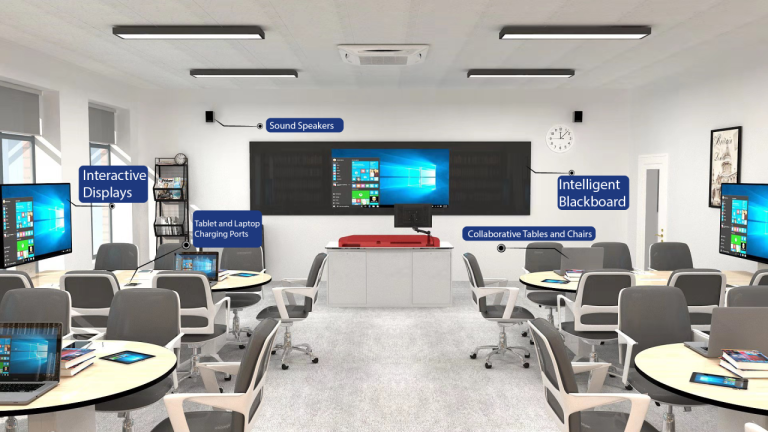
Introduction to Smart Office Technology
In the modern workplace, Smart AV Technology is no longer a luxury but a necessity. Audio-visual (AV) systems form the backbone of these innovations, revolutionizing how we collaborate, communicate, and operate daily. By integrating AV technology into smart office designs, businesses can enhance productivity, reduce operational costs, and create a more engaging environment for employees and clients alike.
Key Benefits of AV Technology in Smart Offices
Enhanced Collaboration
AV technology facilitates seamless communication across distributed teams. Features such as high-definition video conferencing, wireless presentation systems, and interactive whiteboards bridge the gap between physical and virtual workspaces. These systems foster real-time collaboration, enabling employees to focus on innovation rather than troubleshooting outdated technology.
Improved Productivity
Smart offices equipped with AV systems automate repetitive tasks, streamline workflows, and eliminate inefficiencies. For example, voice-activated controls allow employees to adjust lighting, temperature, and AV equipment without interrupting their focus.
Cost Efficiency
Energy-efficient AV solutions reduce utility costs while maintaining optimal performance. For instance, intelligent lighting systems integrated with occupancy sensors ensure energy is consumed only when necessary, minimizing waste.
Enhanced Client Experiences
A smart office equipped with state-of-the-art AV technology leaves a lasting impression on clients. Dynamic digital signage, immersive video walls, and automated room scheduling demonstrate a commitment to innovation and professionalism.
Components of a Future-Ready AV System
High-Definition Video Conferencing
Video conferencing systems are at the heart of modern communication. Key features include:
- Crystal-Clear Resolution: High-definition cameras and displays ensure participants appear sharp and lifelike.
- Noise Reduction Technology: Advanced microphones and speakers eliminate background noise for distraction-free conversations.
- Multi-Platform Compatibility: Seamless integration with platforms such as Zoom, Microsoft Teams, and Google Meet.
Interactive Collaboration Tools
Interactive tools foster creativity and engagement among teams. Examples include:
- Smart Whiteboards: Digital whiteboards allow participants to brainstorm, annotate, and share ideas in real-time.
- Wireless Presentation Systems: Employees can present from any device, reducing setup time and enhancing flexibility.
- Collaboration Hubs: Centralized systems for document sharing and task management.
Digital Signage and Displays
Digital signage offers versatile solutions for communication and branding. Key applications include:
- Internal Communication: Display announcements, performance metrics, and team achievements.
- Visitor Engagement: Welcome guests with personalized messages and interactive maps.
- Marketing Campaigns: Showcase promotional content dynamically in high-traffic areas.
Intelligent Room Scheduling
Automated scheduling systems streamline the use of meeting spaces. Features include:
- Real-Time Availability: Digital displays outside meeting rooms show current bookings and availability.
- Integration with Calendars: Sync with tools like Outlook and Google Calendar for hassle-free scheduling.
- Energy Efficiency: Rooms automatically release resources if meetings are canceled or rescheduled.
AV Control Systems
Control systems simplify the operation of complex AV setups. Features include:
- Centralized Management: Unified control of lighting, audio, visual, and environmental settings.
- User-Friendly Interfaces: Touchscreen panels and mobile apps for intuitive operation.
- Automation: Preset configurations for different scenarios, such as presentations, conferences, or training sessions.
The Role of AV in Workplace Sustainability
Energy Management
Smart offices prioritize sustainability with AV solutions designed for energy efficiency. Examples include:
- Adaptive Lighting: Automated systems adjust brightness based on natural light and occupancy.
- Efficient Displays: LED screens consume less energy compared to traditional displays.
- Power Management: Smart plugs and timers ensure devices are powered off when not in use.
Reducing Carbon Footprint
By enabling remote work and virtual collaboration, AV technology significantly reduces the need for travel, contributing to lower carbon emissions.
Sustainable Materials
Many AV manufacturers are adopting eco-friendly practices, such as using recyclable materials and reducing packaging waste, to align with corporate sustainability goals.
Future Trends in Smart Office AV Systems
Artificial Intelligence Integration
AI enhances AV systems by automating tasks and improving efficiency. For instance:
- Predictive maintenance identifies potential issues before they disrupt operations.
- Virtual assistants manage meeting schedules and control AV equipment.
Augmented and Virtual Reality
AR and VR are transforming training and presentations. Immersive environments allow employees to visualize complex concepts, enhancing learning and retention.
5G Connectivity
Faster internet speeds with 5G unlock the potential for real-time collaboration and high-quality video streaming, even in bandwidth-intensive scenarios.
Transform Your Workplace Today
Ready to create a smarter, more efficient office environment? Partner with us to design and implement cutting-edge AV solutions tailored to your business needs. Enhance collaboration, reduce costs, and elevate client experiences with technology that works seamlessly. Contact us today to take the first step toward a future-ready workplace.
Conclusion:
Smart offices powered by innovative AV technology are redefining the modern workplace. By enhancing collaboration, boosting productivity, and aligning with sustainability goals, these systems deliver long-term value. Investing in future-ready AV solutions positions your organization as a leader in innovation and efficiency, ensuring success in an ever-evolving business landscape.